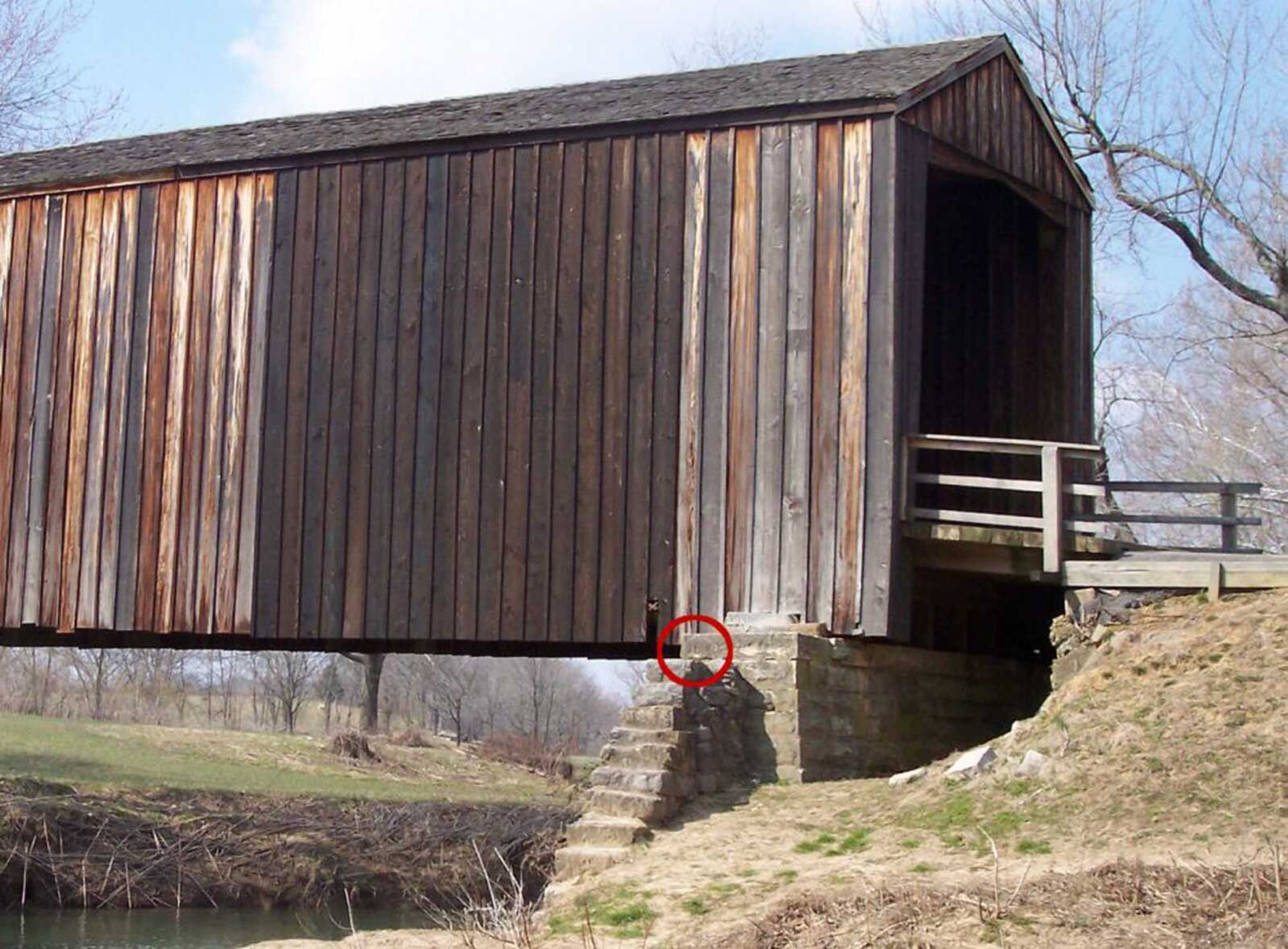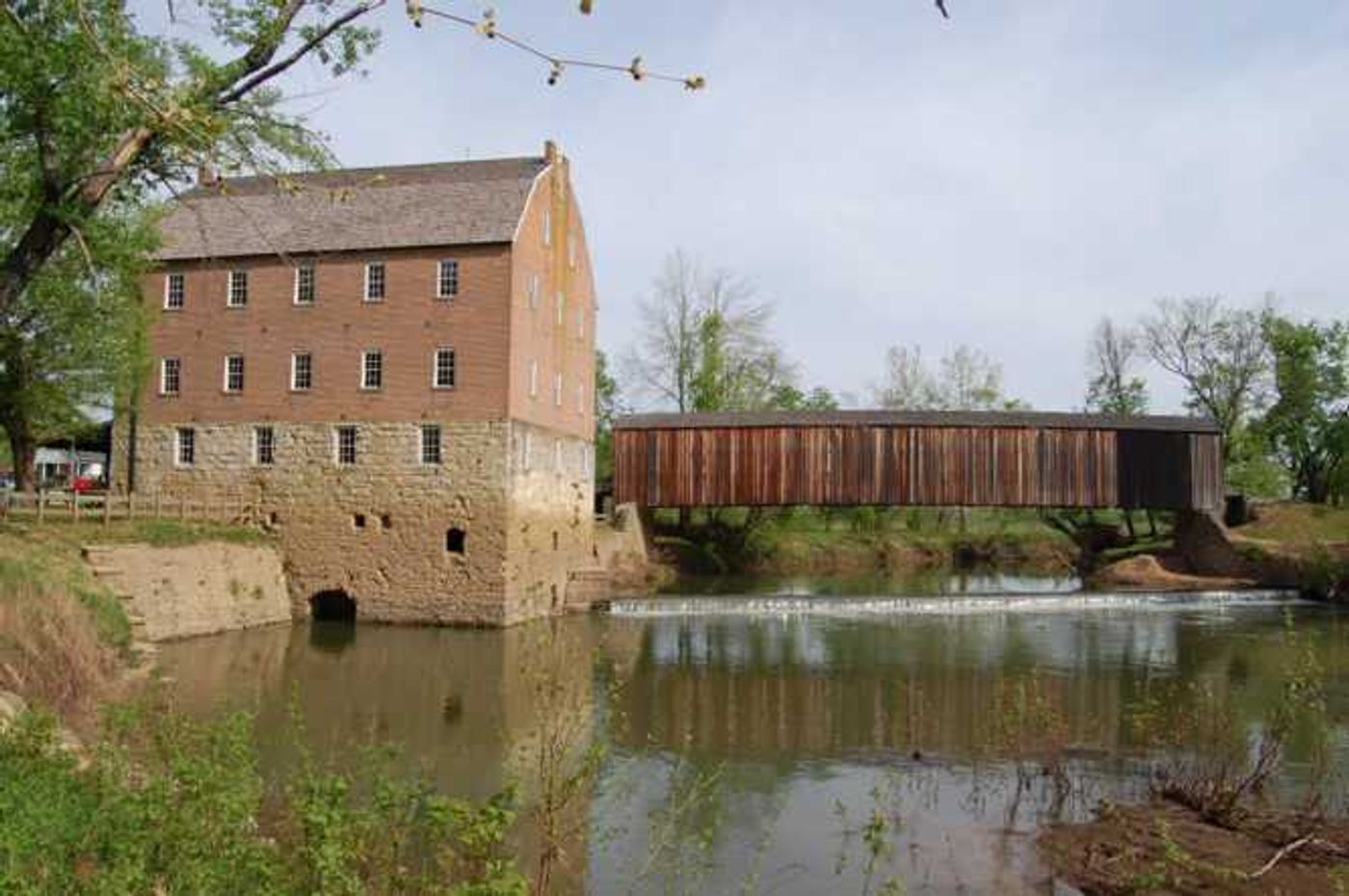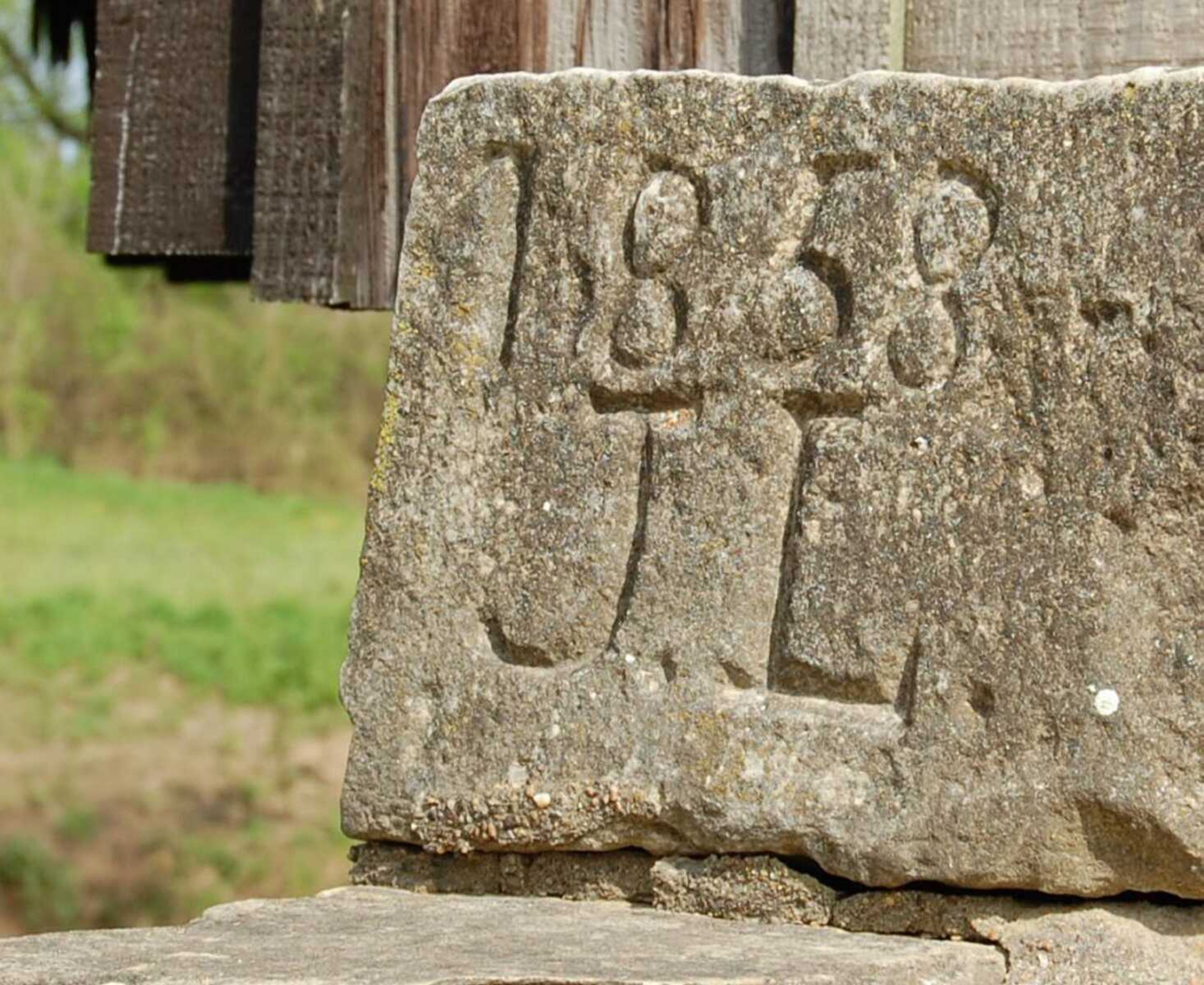The man who built Cape Girardeau
(Editor's note: James Baughn recently died in a hiking accident. In coming weeks, we will republish some of his writings.) Originally published in his blog, "Pavement Ends," Dec. 28, 2012. Perhaps you have seen a cornerstone etched with the initials "J.L." and the date "1858." Do you know where this is?...
(Editor's note: James Baughn recently died in a hiking accident. In coming weeks, we will republish some of his writings.)
Originally published in his blog, "Pavement Ends," Dec. 28, 2012.
Perhaps you have seen a cornerstone etched with the initials "J.L." and the date "1858." Do you know where this is?
It's a very well-known landmark in Cape Girardeau County. Maybe it will help if I zoom out:
This is the Burfordville Covered Bridge, which, when combined with the adjacent Bollinger Mill, is one of the most photographed sites in Southeast Missouri.

The bridge was built by Joseph Lansman, a man who is attached to a surprising number of landmarks in Cape Girardeau and Perry counties. In this case, the cornerstone marks the date when he started construction.
It's a shame that he only left his initials, and not his full name, since the exact spelling has remained a bit of a mystery, with sources using Lansman, Lansmon, Landsman, and Lansmann interchangeably. Then again, Americans in the 1800s weren't nearly as pedantic about spelling as we are in modern times.
And, as it turns out, Lansman wasn't his real name. He was born 1812 as Joseph Hoche in the Alsace-Lorraine region of Europe. This is currently a part of France, but it has switched between France and Germany at different times in history as the result of various wars and conflicts.
Faced with the ugly prospect of being conscripted into the French military, Joseph and other family members assumed new identities and fled to the United States during the early 1830s. In the Old World, he had apprenticed as a bricklayer, and his skills were in demand in the New World.
It's unclear how he came to Missouri, but he found work as the builder for the Vincentian missionaries as they established a Catholic parish in Cape Girardeau. The Vincentians had acquired a large tract of land to the south of town, and they set to work building a church, parochial schools, and a college. Lansman oversaw construction of the following buildings and structures:

First St. Vincent's Church (1838)
Priests residence (1838)
St. Vincent's Male Academy (1838)
St. Vincent's Young Ladies Academy (1840)
St. Vincent's College (Block 1, 1843)
First handball court (1843)
As part of their real estate acquisitions, the Vincentians also owned the Red House, the abandoned home of town founder Louis Lorimier. After marrying Carolina Anna Cordell in 1842, the Lansmans moved into the Red House, conveniently located next door to the first St. Vincent's Church. Carolina would have her hands full, giving birth to 13 children. (Curiously, the marriage is recorded twice: once in Cape Girardeau County and again in Baltimore, Maryland.)
The Vincentians suffered two major disasters which would add to Lansman's workload. First, in 1848, the SEA BIRD, a cargo ship carrying a large quantity of gunpowder, was docked below St. Vincent's College while waiting for ice on the river to clear before proceeding to St. Louis. A fire broke out on the ship, and you can imagine what happened next. The president of St. Vincent's College, John F. McGerry, wrote this account:
"The students had time to quit the college and to go about two miles into the country. The explosion was terrific. Every door and window in the college was dashed to pieces. The roof [was] raised some inches and then settled nearly in its former place. The plastering on all the rooms of the college was broken and thrown down. The college appeared [to] be a complete wreck."
He added, in credit to Lansman's masonry work, "The walls were so solid that the shock had not the least effect on them."
Lansman was called to oversee repairs, and he was just wrapping up the work when a second, more serious disaster would strike. On Nov. 27, 1850, a tornado ripped through the Vincentian grounds, completely destroying St. Vincent's Church and the Red House, while severely damaging the main college building. It's likely that all three buildings took a direct hit from the tornado.
Students were sent home the next day, but work soon started on rebuilding the college and church. Lansman worked on both -- while also juggling the urgent need to find a new home for his rapidly growing family after the Red House was destroyed. He picked a convenient location to construct a new home, 139 S. Spanish, which was right across the street from the second St. Vincent's Church he was building.
By 1852, the Vincentians had recovered from the tornado, with the college and church rebuilt better than ever. The college was now double in size thanks to a new wing. Handball must have been a popular student activity, since Lansman was directed to build a second handball court in 1853.
During all of this activity, Lansman somehow found the time to work at another Vincentian outpost, the St. Mary's of the Barrens campus at Perryville. He constructed Academic Hall (also called Rosati Hall or the Administration Building) in 1850.
Church records show that Lansman was often paid in goods (food, cloth, etc.) rather than cash. In the book Our Dear Brother Joseph: The Life of Joseph Lansman by Sharon Sanders and Diana Bryant, the authors write, "This cashless way of doing business also explains why Lansman chose another, unique method of paying off his plasterers, carpenters, and other more reliable laborers: He built them small German-style cottages using bricks he furnished from his own kiln."
Many brick cottages can still be seen around Cape Girardeau. Take, for example, the house at 24 S. Lorimier.
Each window is set on a block of stone and features a subtle curved arch above. The rest of the brickwork is simple, but includes one embellishment: the topmost row of bricks is turned at a 45-degree angle.
According to family lore, the Fuerth House at 119 S. Spanish was built by Lansman. The window treatments are slightly different, with stone lentils above the windows. Like many of his cottages, the brick walls rest on a stone foundation and the chimneys are flush with the side walls.
The house at 323 Themis was possibly built by Lansman. It, too, features the same architectural details: arched windows, turned bricks, and stone foundation.
Driving around Cape, it's surprising how many homes in the older parts of town share these details. Lansman, however, wasn't the only builder in the area who practiced "German vernacular" style, so not all of these houses were built by him. But some -- or many -- probably were.
Lansman often worked as a subcontractor for other builders. The Reynolds House on North Main Street was built using Lansman bricks -- 51,000 of them, to be exact, at a cost of $475. The house was designed by architect Edwin Branch Deane following "French Colonial" style, a departure from the style that Lansman typically built.
In addition to Vincentian projects and brick cottages, Lansman also tackled large public buildings in Cape Girardeau and Jackson. His most notable landmark is the Common Pleas Courthouse, built 1854. As I described in a previous blog, this historic landmark was almost demolished by the federal government to make room for a post office, but was spared thanks to an interesting series of courtroom and political skirmishes.
Lansman also constructed the St. Charles Hotel, Riverview Hotel, and Union Mill in the downtown area, but these structures have long since been razed. St. Mary's German Catholic Church, opened in 1869, has avoided that fate. Lansman served as president of the church's building committee -- and, not so coincidentally, the board hired him to do the brickwork.
In 1870, county officials hired Lansman to build a new courthouse in Jackson to replace the previous building that had burned. The Cape Girardeau Weekly Argus on Dec. 15, 1870, included this colorful editorial about the decision:
"GOOD OUT OF EVIL"
"Our stupid County Court have at last blundered into one good act, which we hasten to record. They, on last Monday, left the building of the Court House to our townsman, Jos. Lansmon. For this one (and first) act of theirs divested of bigotry and prejudice, they are entitled to the thanks of honest men. Mr. L. will do it in a manner that the people will have no cause to complain of hereafter. The price paid is $24,900 -- the work to be completed January 1, 1872."
It's clear that Lansman had firmly established his reputation. The new courthouse was dedicated in 1872, but it fell into disrepair and was eventually replaced by the current courthouse in 1905.
As I explained in my previous blog, Lansman's next major project, in 1873, was the construction of the Third District Normal School main building. He had donated the land for the new college, but his generosity didn't sway the Board of Regents when it came time to select the general contractor. They went with the lowest bidder, William E. Gray of Alton, Illinois. However, Lansman was later hired as subcontractor for the brickwork. The Normal School was completed in 1875, but it was destroyed by fire on April 7, 1902.
If all of these building projects weren't enough, Lansman had also branched out into road, bridge, and railroad construction. He is most famous, as mentioned earlier, for the Burfordville Covered Bridge, but that's not the only covered bridge he oversaw. He was president of the "Cape Girardeau and Bloomfield McAdamized and Gravel Road Company" which built a covered bridge at Allenville.
This bridge was destroyed by a severe thunderstorm in 1945. The site is now marked by a small non-descript concrete bridge at the southwest edge of Allenville on County Road 238.
He oversaw other bridge projects along the Bloomfield Road, as shown by (an) advertisement in the Cape Girardeau Weekly Argus newspaper from 1870.
The "Howe's patent" mentioned in the ad is the same design he had used previously for the Burfordville Covered Bridge, suggesting that he intended to build a covered bridge over Castor River. I'd love to be able to see his "plans and specifications."
Lansman also apparently dabbled in a venture to bring a railroad to Cape Girardeau. The Missouri Cash-Book from May 22, 1872, includes a story about an election for the board of directors of the Cape Girardeau & State Line Rail Road Company. The list of election winners is a veritable "Who's Who" of Cape Girardeau businessmen at the time, including Ivers, Thilenius, Klostermann, Sturdivant, and Vasterling. Lansman was elected to the board with 4,574 shareholder votes (third behind Ivers and Thilenius).
What is most amusing is that Louis Houck only received 2 votes! Of course, Houck would eventually bring a railroad to Cape Girardeau, long after the State Line Railroad Company had become a total bust.
Up until his death in 1895, Lansman continued to be active in building projects. In 1892, he was in Perryville overseeing work to add a new college building to the St. Marys of the Barrens campus. An article in the Perry County Sun stated, "Mr. Lansman is quite an old gentleman, now in his 81st year, but is more active in business than many men half his age."
Despite his many accomplishments, Lansman's death did not generate much press. The Cape Girardeau Democrat only included this brief notice on Mar. 2, 1895: "A Large Funeral. St. Vincent's Catholic Church was crowded Sunday at the funeral services of Joseph Lansmon. Mr. Lansmon was an old and honored citizen and a large number of our oldest citizens followed his remains to their last resting place."
His death didn't go totally unnoticed, however. A few weeks later, the same newspaper reported that a group of bricklayers from St. Louis had presented the Lansman family with resolutions "artisticly drafted and framed in a handsome frame." These bricklayers had worked under Lansman; they called themselves "Old Joe's Boys." St. Louis, of course, is filled with German-style brick buildings, and it's quite possible that some of these buildings were built by masons who were inspired by Lansman.
Today, he is buried at Old Lorimier Cemetery in a plot adjacent to Louis Lorimier's pagoda. This is strangely appropriate since Lansman lived in Lorimier's house. Curiously, Joseph Lansman's headstone does not have any dates or other details other than his name.
Lansman's significance to local history has not been widely celebrated, even though he did more to physically build Cape Girardeau than almost anybody else. In their book, Sharon Sanders and Diane Bryant compiled a lengthy list of structures known to have been built by Lansman, plus a dizzying list of other buildings that he possibly constructed. I've plotted these locations on a map -- although I'm sure it is far from complete.
This map clearly shows that Joseph Lansman was, as I like to call him, The Man Who Built Cape Girardeau.
Sources
Our Dear Brother Joseph: The Life of Joseph Lansman by Sharon Sanders and Diana Bryant (Cape Girardeau County Genealogical Society, 1999)
National Register of Historic Places nomination forms for St. Vincents College Building, Burfordville Covered Bridge, Cape Girardeau Court of Common Pleas, St. Vincent de Paul Catholic Church, James Reynolds House, House at 323 Themis Street, Old Lorimier Cemetery, and St. Mary's of the Barrens Historic District
'God is Wonderful in All His Works': A Contemporary Account of Vincentian Activity in the District of Cape Girardeau, Missouri, 1828-1850 by John F. McGerry and Douglas Slawson, Vincentian Heritage Journal (1986)
Various newspaper clippings from the Chronicling America project at the Library of Congress website
To read the rest of this blog, go to semissourian.com/blogs/pavementends/entry/51011
Connect with the Southeast Missourian Newsroom:
For corrections to this story or other insights for the editor, click here. To submit a letter to the editor, click here. To learn about the Southeast Missourian’s AI Policy, click here.









